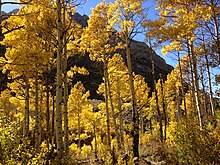Quaking aspen
| Quaking aspen | |
|---|---|
 |
|
| Quaking aspen grove in Lamoille Canyon, Nevada, U.S. | |
| Scientific classification | |
| Kingdom: | Plantae |
| (unranked): | Angiosperms |
| (unranked): | Eudicots |
| (unranked): | Rosids |
| Order: | Malpighiales |
| Family: | Salicaceae |
| Genus: | Populus |
| Section: | Populus |
| Species: | P. tremuloides |
| Binomial name | |
|
Populus tremuloides Michx. |
|
 |
|
Populus tremuloides is a deciduous tree native to cooler areas of North America, one of several species referred to by the common name aspen. It is commonly called quaking aspen,trembling aspen,American aspen,Quakies,mountain or golden aspen,trembling poplar,white poplar,popple, and even more names. The trees have tall trunks, up to 25 meters (82 feet) tall, with smooth pale bark, scarred with black. The glossy green leaves, dull beneath, become golden to yellow, rarely red, in autumn. The species often propagates through its roots to form large groves originating from a shared system of rhizomes.
Populus tremuloides is the most widely distributed tree in North America, being found from Canada to central Mexico. It is the defining species of the aspen parkland biome in the Prairie Provinces of Canada and extreme northwest Minnesota.
The quaking or trembling of the leaves that is referred to in the common names is due to the flexible flattened petioles. The specific epithet, tremuloides, evokes this trembling behavior and can be literally translated as "like (Populus) tremula", the European trembling aspen.
Some species of Populus have petioles flattened partially along their length, while the aspens and some other poplars have them flattened from side to side along the entire length of the petiole.
Quaking aspen is a tall, fast growing tree, usually 20–25 m (65–80 ft) at maturity, with a trunk 20 to 80 cm (8 inches to 2 feet 7 inches) in diameter; records are 36.5 m (119 ft 9 in) in height and 1.37 m (4 ft 6 in) in diameter.
The bark is relatively smooth, colored greenish-white to gray, and is marked by thick black horizontal scars and prominent black knots. Parallel vertical scars are tell-tale signs of elk, which strip off aspen bark with their front teeth.
The leaves on mature trees are nearly round, 4–8 centimeters (1 1⁄2–3 1⁄4 inches) in diameter with small rounded teeth, and a 3–7-centimeter (1 1⁄4–2 3⁄4-inch) long, flattened petiole. Young trees and root sprouts have much larger (10–20 centimeters, 4–8 in long) nearly triangular leaves.
...
Wikipedia
